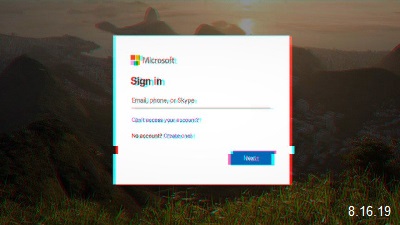|
Microsoft security researchers discovered an unusual phishing campaign which employs custom 404 error pages to trick potential victims into handing out their Microsoft credentials. To do this, the attackers register a domain and instead of creating a single phishing landing page to redirect their victims to, they configure a custom 404 page which shows the fake login form. This allows the phishers to have an infinite amount of phishing landing pages URLs generated with the help of a single registered domain. "The 404 Not Found page tells you that you’ve hit a broken or dead link – except when it doesn’t," says Microsoft's research team. "Phishers are using malicious custom 404 pages to serve phishing sites. A phishing campaign targeting Microsoft uses such technique, giving phishers virtually unlimited phishing URLs." "Phishers are using malicious custom 404 pages to serve phishing sites. A phishing campaign targeting Microsoft uses such technique, giving phishers virtually unlimited phishing URLs." The custom 404 error pages these attackers use to harvest their victims' credentials are perfectly camouflaged as legitimate Microsoft account sign-in pages, down to the smallest details. All the links on the phishing page, including the ones at the bottom and the ones used to access one's Microsoft account and to create a new one, are directing straight to official Microsoft login forms in an effort to make targets less suspicious. The only elements missing from the phishing page are the "Sign-in options" link above the "Next" button and the cookies notification at the top of the page. "Because the malformed 404 pages are served to any non-existent URL in an attacker-controlled domain, the phishers can use random URLs for their campaigns," adds Microsoft. "We also found that the attackers randomize domains, exponentially increasing the number of phishing URLs." Learn more by visiting OUR FORUM. A new Bluetooth vulnerability named "KNOB" has been disclosed that allow attackers to more easily brute force the encryption key used during pairing to monitor or manipulate the data transferred between two paired devices. In a coordinated disclosure between Center for IT-Security, Privacy and Accountability (CISPA), ICASI, and ICASI members such as Microsoft, Apple, Intel, Cisco, and Amazon, a new vulnerability called "KNOB" has been disclosed that affects Bluetooth BR/EDR devices, otherwise known as Bluetooth Classic, using specification versions 1.0 - 5.1. This flaw has been assigned CVE ID CVE-2019-9506 and allows an attacker to reduce the length of the encryption key used for establishing a connection. In some cases, an attacker could reduce the length of an encryption key to a single octet. "The researchers identified that it is possible for an attacking device to interfere with the procedure used to set up encryption on a BR/EDR connection between two devices in such a way as to reduce the length of the encryption key used," stated an advisory on Bluetooth.com. "In addition, since not all Bluetooth specifications mandate a minimum encryption key length, it is possible that some vendors may have developed Bluetooth products where the length of the encryption key used on a BR/EDR connection could be set by an attacking device down to a single octet." This reduction in key length would make it much easier for an attacker to brute force the encryption key used by the paired devices to communicate with each other. Once the key was known to the attackers, they could monitor and manipulate the data being sent between the devices. This includes potentially injecting commands, monitoring keystrokes, and other types of behavior. Full details are posted on OUR FORUM. The company launches FastTrack for Windows 10 guidance, providing experts who can talk through deployment scenarios with partners. Microsoft Monday unveiled a new benefit for partners that are moving customers from Windows 7 to Windows 10, with the company now offering expert assistance around Windows 10 deployments. The end of support date for Windows 7 is set for Jan. 14, 2020, and Microsoft has made a series of investments to help with the transition, said Bob Davis, corporate vice president for Microsoft 365, in a blog post. The latest of these investments is the launch of FastTrack for Windows 10 deployment guidance. The benefit takes the form of free expert assistance on Windows 10 deployments for situations where there are at least 150 licenses of an eligible service or plan. "Sometimes you have a complex scenario and aren’t even sure where to start, or you’ve encountered a problem that has your migration stalled. There are times when you need to talk to an expert to get guidance on where to go next," Davis said. FastTrack, Davis said in the post, will assist with envisioning a technical plan and determining how to deploy new users—and will continue to offer help throughout the deployment. Read more: Microsoft Partners Get More Assistance For Windows 7 To Windows 10 Transition. |
Latest Articles
|


